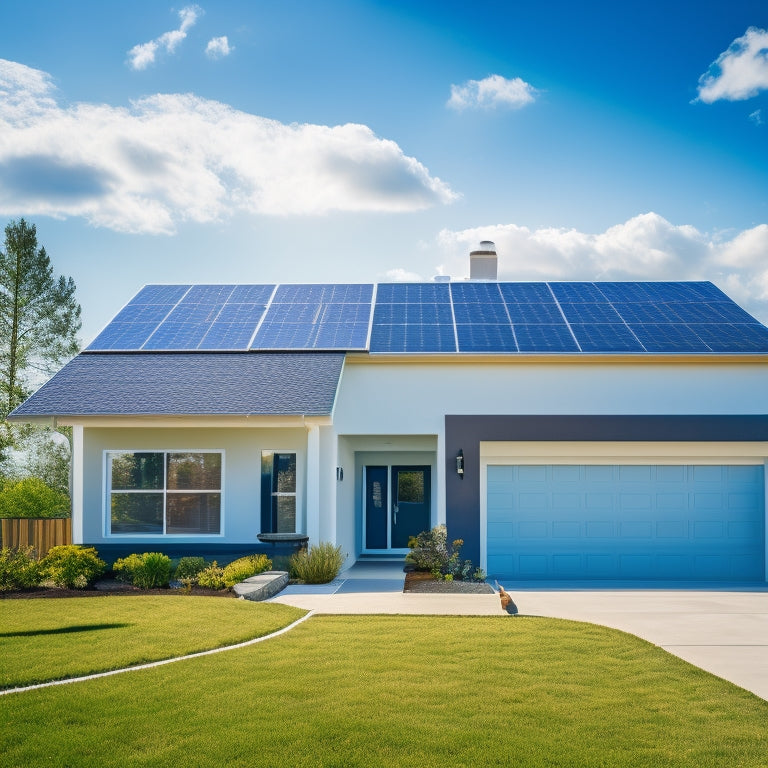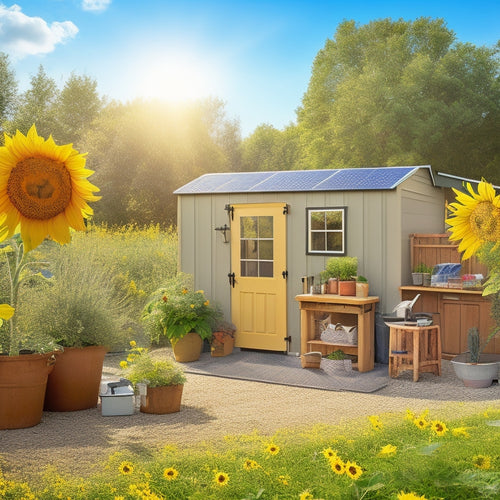
Install Home Solar Battery in 5 Easy Steps
Share
You're about to join the 90% of homeowners with solar panels who also invest in solar batteries, taking an essential step towards energy independence. To get started, assess your energy needs by analyzing your consumption patterns, identifying high-power appliances, and determining the right battery size. Next, choose the right battery type, considering pros and cons, performance metrics, and cost comparisons. Prepare your home's electrical system, ensuring compatibility and safety standards. Then, install the solar battery in a suitable location, following manufacturer instructions and local codes. Finally, monitor and maintain performance to optimize energy efficiency and extend your battery's lifespan - and that's just the beginning of your solar battery expedition.
Key Takeaways
- Assess energy needs by analyzing consumption patterns, peak usage, and seasonal changes to determine the right battery size and type.
- Choose the right battery by evaluating types, performance metrics, and cost, considering factors like capacity, efficiency, and warranty.
- Prepare your home's electrical system by ensuring compatibility, addressing existing issues, and meeting safety standards and local codes.
- Install the solar battery in a suitable location, following manufacturer instructions and local codes, and implement real-time monitoring.
- Monitor and maintain performance by tracking energy production and consumption, performing routine software updates, and scheduling annual maintenance.
Assess Your Energy Needs
About 90% of homeowners who install solar panels also invest in a home solar battery to optimize their energy independence and savings.
To get the most out of your solar battery, you'll need to assess your energy needs. Start by analyzing your energy consumption patterns over the past year, including peak usage hours and seasonal fluctuations.
With online renewable energy marketplaces offering vast selections of products and services, it's now easier than ever to find the right solutions for your energy needs.
Conduct a load analysis to identify the appliances and devices that consume the most power. This will help you determine the size and type of solar battery you need to meet your energy demands.
Choose the Right Battery
Your energy needs assessment is complete, and now it's time to select the right solar battery for your system.
You'll need to evaluate various battery types, including lead-acid, lithium-ion, and saltwater batteries. Each type has its pros and cons, so it's important to research and compare their features.
For example, lithium-ion batteries are more expensive but offer higher efficiency and a longer lifespan. Lead-acid batteries, on the other hand, are more affordable but heavier and less efficient.
When choosing a battery, it's vital to assess performance metrics such as capacity and efficiency, as well as maintenance-free designs that reduce electrical shock risks.
Conduct a cost comparison to determine which option best fits your budget and energy requirements. Additionally, evaluate factors like depth of discharge, round-trip efficiency, and warranty when making your decision.
Prepare Your Home's Electrical
You're one step closer to utilizing the power of solar energy, but before installing your home solar battery, you'll need to secure your home's electrical system is ready for the upgrade. This involves evaluating your home's wiring requirements and addressing any safety considerations.
| Electrical Component | Checklist |
|---|---|
| Main electrical panel | Verify it can accommodate the solar battery's electrical output |
| Wiring and connections | Confirm they're compatible with the battery's voltage and amperage ratings |
| Grounding system | Validate it's properly installed and meets safety standards |
Install the Solar Battery
Installing the Solar Battery
Installing the solar battery marks a significant milestone in your shift to renewable energy. Now, it's time to follow the installation guidelines to guarantee a safe and efficient setup.
Begin by identifying a suitable location for the battery, considering factors like ventilation, temperature, and accessibility. Confirm the area is clear of flammable materials and meets battery safety standards.
Additionally, contemplate the importance of real-time monitoring to optimize energy efficiency and identify high usage areas, which can help lower energy bills.
Next, connect the battery to your solar panel system, following the manufacturer's instructions and local electrical codes. Secure the battery to the floor or wall to prevent it from shifting or falling.
Monitor and Maintain Performance
The solar battery system's performance relies heavily on regular monitoring and maintenance to guarantee ideal energy storage and efficiency.
You'll want to keep a close eye on your system's performance to verify it's operating at its best. To do this, you'll need to:
-
Track energy production and consumption: Monitor your energy usage and production to identify areas for improvement.
-
Perform routine software updates: Keep your system's software up-to-date to verify peak performance.
-
Check battery health: Regularly inspect your battery's state of charge, voltage, and temperature to prevent degradation.
- Schedule annual maintenance: Hire a professional to inspect and maintain your system to extend its battery lifespan.
Frequently Asked Questions
Can I Use a Solar Battery With an Existing Solar Panel System?
Did you know that over 40% of US households already have solar panels installed? Now, you're wondering if you can use a solar battery with your existing solar system. The good news is that, in most cases, you can, as long as your existing system is compatible with the solar battery's specifications.
Are Solar Batteries Safe From Hacking and Cyber Threats?
You're right to worry about solar battery security; however, you'll be relieved to know that reputable manufacturers implement strong cybersecurity measures, including battery encryption, to protect your system from hacking and cyber threats, ensuring your energy storage remains safe and secure.
Do Solar Batteries Come With a Warranty or Guarantee?
You'll find that most solar batteries come with a warranty, typically ranging from 5 to 15 years, depending on the battery type; lithium-ion batteries often have longer warranty durations, while lead-acid batteries may have shorter guarantees.
Can I Install a Solar Battery Myself, or Do I Need a Professional?
You're wondering if you can install a solar battery yourself or need a pro. Considering DIY, you'll need to meet specific installation requirements, including electrical knowledge and safety precautions, but lacking these, it's recommended you hire a licensed electrician to guarantee a safe and compliant installation.
Will a Solar Battery Work During a Power Outage at Night?
You'll be pleased to know that a solar battery can provide nighttime power during an outage, but its efficiency depends on factors like battery capacity, charge level, and your home's energy usage, so plan accordingly for reliable backup power.
Related Posts
-

Building an Emergency Backup Solar Power System in 5 Essential Steps
Building an emergency backup solar power system involves five key steps. First, assess your daily energy needs to ide...
-

High-Efficiency Solar Battery Chargers for Remote Areas
High-efficiency solar battery chargers are essential for your off-grid energy needs in remote areas. They maximize en...
-

Advantages of Commercial Solar Battery On-Site Storage
By investing in a commercial solar battery on-site storage system, you can greatly reduce your energy grid dependence...


